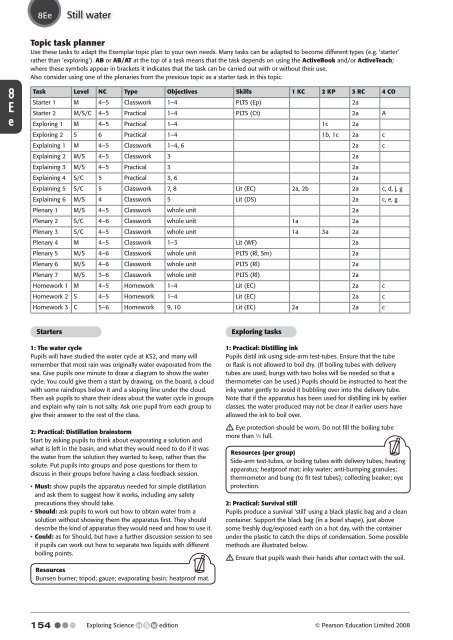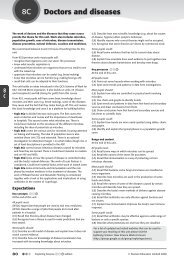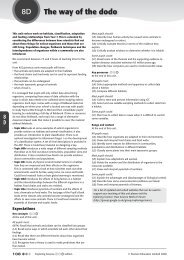8E TEACHER GUIDE.pdf - swallowhillresources
8E TEACHER GUIDE.pdf - swallowhillresources
8E TEACHER GUIDE.pdf - swallowhillresources
- No tags were found...
You also want an ePaper? Increase the reach of your titles
YUMPU automatically turns print PDFs into web optimized ePapers that Google loves.
<strong>8E</strong>eStill water<strong>8E</strong>eTopic task plannerUse these tasks to adapt the Exemplar topic plan to your own needs. Many tasks can be adapted to become different types (e.g. ‘starter’rather than ‘exploring’). AB or AB/AT at the top of a task means that the task depends on using the ActiveBook and/or ActiveTeach;where these symbols appear in brackets it indicates that the task can be carried out with or without their use.Also consider using one of the plenaries from the previous topic as a starter task in this topic.Task Level NC Type Objectives Skills 1 KC 2 KP 3 RC 4 COStarter 1 M 4–5 Classwork 1–4 PLTS (Ep) 2aStarter 2 M/S/C 4–5 Practical 1–4 PLTS (Ct) 2a AExploring 1 M 4–5 Practical 1–4 1c 2aExploring 2 S 6 Practical 1–4 1b, 1c 2a cExplaining 1 M 4–5 Classwork 1–4, 6 2a cExplaining 2 M/S 4–5 Classwork 3 2aExplaining 3 M/S 4–5 Practical 3 2aExplaining 4 S/C 5 Practical 3, 6 2aExplaining 5 S/C 5 Classwork 7, 8 Lit (EC) 2a, 2b 2a c, d, j, gExplaining 6 M/S 4 Classwork 5 Lit (DS) 2a c, e, gPlenary 1 M/S 4–5 Classwork whole unit 2aPlenary 2 S/C 4–6 Classwork whole unit 1a 2aPlenary 3 S/C 4–5 Classwork whole unit 1a 3a 2aPlenary 4 M 4–5 Classwork 1–3 Lit (WF) 2aPlenary 5 M/S 4–6 Classwork whole unit PLTS (Rl, Sm) 2aPlenary 6 M/S 4–6 Classwork whole unit PLTS (Rl) 2aPlenary 7 M/S 3–6 Classwork whole unit PLTS (Rl) 2aHomework 1 M 4–5 Homework 1–4 Lit (EC) 2a cHomework 2 S 4–5 Homework 1–4 Lit (EC) 2a cHomework 3 C 5–6 Homework 9, 10 Lit (EC) 2a 2a cStarters1: The water cyclePupils will have studied the water cycle at KS2, and many willremember that most rain was originally water evaporated from thesea. Give pupils one minute to draw a diagram to show the watercycle. You could give them a start by drawing, on the board, a cloudwith some raindrops below it and a sloping line under the cloud.Then ask pupils to share their ideas about the water cycle in groupsand explain why rain is not salty. Ask one pupil from each group togive their answer to the rest of the class.2: Practical: Distillation brainstormStart by asking pupils to think about evaporating a solution andwhat is left in the basin, and what they would need to do if it wasthe water from the solution they wanted to keep, rather than thesolute. Put pupils into groups and pose questions for them todiscuss in their groups before having a class feedback session.• Must: show pupils the apparatus needed for simple distillationand ask them to suggest how it works, including any safetyprecautions they should take.• Should: ask pupils to work out how to obtain water from asolution without showing them the apparatus first. They shoulddescribe the kind of apparatus they would need and how to use it.• Could: as for Should, but have a further discussion session to seeif pupils can work out how to separate two liquids with differentboiling points.ResourcesBunsen burner; tripod; gauze; evaporating basin; heatproof mat.Exploring tasks1: Practical: Distilling inkPupils distil ink using side-arm test-tubes. Ensure that the tubeor flask is not allowed to boil dry. (If boiling tubes with deliverytubes are used, bungs with two holes will be needed so that athermometer can be used.) Pupils should be instructed to heat theinky water gently to avoid it bubbling over into the delivery tube.Note that if the apparatus has been used for distilling ink by earlierclasses, the water produced may not be clear if earlier users haveallowed the ink to boil over. Eye protection should be worn. Do not fill the boiling tubemore than 1 / 3 full.Resources (per group)Side-arm test-tubes, or boiling tubes with delivery tubes; heatingapparatus; heatproof mat; inky water; anti-bumping granules;thermometer and bung (to fit test tubes); collecting beaker; eyeprotection.2: Practical: Survival stillPupils produce a survival ‘still’ using a black plastic bag and a cleancontainer. Support the black bag (in a bowl shape), just abovesome freshly dug/exposed earth on a hot day, with the containerunder the plastic to catch the drips of condensation. Some possiblemethods are illustrated below. Ensure that pupils wash their hands after contact with the soil.154Exploring Science edition © Pearson Education Limited 2008






